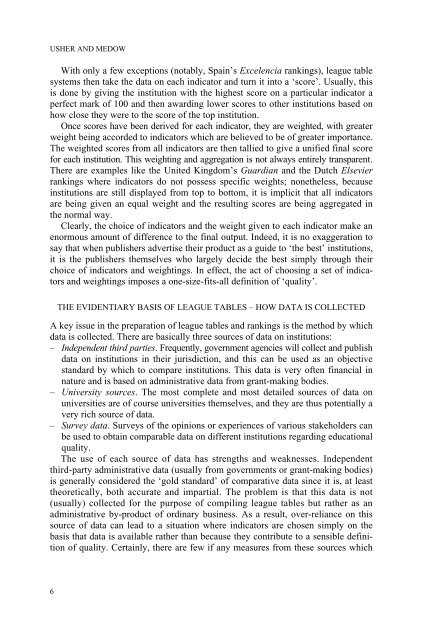University Rankings, Diversity, and the New ... - Sense Publishers
University Rankings, Diversity, and the New ... - Sense Publishers
University Rankings, Diversity, and the New ... - Sense Publishers
Create successful ePaper yourself
Turn your PDF publications into a flip-book with our unique Google optimized e-Paper software.
USHER AND MEDOW<br />
With only a few exceptions (notably, Spain’s Excelencia rankings), league table<br />
systems <strong>the</strong>n take <strong>the</strong> data on each indicator <strong>and</strong> turn it into a ‘score’. Usually, this<br />
is done by giving <strong>the</strong> institution with <strong>the</strong> highest score on a particular indicator a<br />
perfect mark of 100 <strong>and</strong> <strong>the</strong>n awarding lower scores to o<strong>the</strong>r institutions based on<br />
how close <strong>the</strong>y were to <strong>the</strong> score of <strong>the</strong> top institution.<br />
Once scores have been derived for each indicator, <strong>the</strong>y are weighted, with greater<br />
weight being accorded to indicators which are believed to be of greater importance.<br />
The weighted scores from all indicators are <strong>the</strong>n tallied to give a unified final score<br />
for each institution. This weighting <strong>and</strong> aggregation is not always entirely transparent.<br />
There are examples like <strong>the</strong> United Kingdom’s Guardian <strong>and</strong> <strong>the</strong> Dutch Elsevier<br />
rankings where indicators do not possess specific weights; none<strong>the</strong>less, because<br />
institutions are still displayed from top to bottom, it is implicit that all indicators<br />
are being given an equal weight <strong>and</strong> <strong>the</strong> resulting scores are being aggregated in<br />
<strong>the</strong> normal way.<br />
Clearly, <strong>the</strong> choice of indicators <strong>and</strong> <strong>the</strong> weight given to each indicator make an<br />
enormous amount of difference to <strong>the</strong> final output. Indeed, it is no exaggeration to<br />
say that when publishers advertise <strong>the</strong>ir product as a guide to ‘<strong>the</strong> best’ institutions,<br />
it is <strong>the</strong> publishers <strong>the</strong>mselves who largely decide <strong>the</strong> best simply through <strong>the</strong>ir<br />
choice of indicators <strong>and</strong> weightings. In effect, <strong>the</strong> act of choosing a set of indicators<br />
<strong>and</strong> weightings imposes a one-size-fits-all definition of ‘quality’.<br />
THE EVIDENTIARY BASIS OF LEAGUE TABLES – HOW DATA IS COLLECTED<br />
A key issue in <strong>the</strong> preparation of league tables <strong>and</strong> rankings is <strong>the</strong> method by which<br />
data is collected. There are basically three sources of data on institutions:<br />
– Independent third parties. Frequently, government agencies will collect <strong>and</strong> publish<br />
data on institutions in <strong>the</strong>ir jurisdiction, <strong>and</strong> this can be used as an objective<br />
st<strong>and</strong>ard by which to compare institutions. This data is very often financial in<br />
nature <strong>and</strong> is based on administrative data from grant-making bodies.<br />
– <strong>University</strong> sources. The most complete <strong>and</strong> most detailed sources of data on<br />
universities are of course universities <strong>the</strong>mselves, <strong>and</strong> <strong>the</strong>y are thus potentially a<br />
very rich source of data.<br />
– Survey data. Surveys of <strong>the</strong> opinions or experiences of various stakeholders can<br />
be used to obtain comparable data on different institutions regarding educational<br />
quality.<br />
The use of each source of data has strengths <strong>and</strong> weaknesses. Independent<br />
third-party administrative data (usually from governments or grant-making bodies)<br />
is generally considered <strong>the</strong> ‘gold st<strong>and</strong>ard’ of comparative data since it is, at least<br />
<strong>the</strong>oretically, both accurate <strong>and</strong> impartial. The problem is that this data is not<br />
(usually) collected for <strong>the</strong> purpose of compiling league tables but ra<strong>the</strong>r as an<br />
administrative by-product of ordinary business. As a result, over-reliance on this<br />
source of data can lead to a situation where indicators are chosen simply on <strong>the</strong><br />
basis that data is available ra<strong>the</strong>r than because <strong>the</strong>y contribute to a sensible definition<br />
of quality. Certainly, <strong>the</strong>re are few if any measures from <strong>the</strong>se sources which<br />
6














